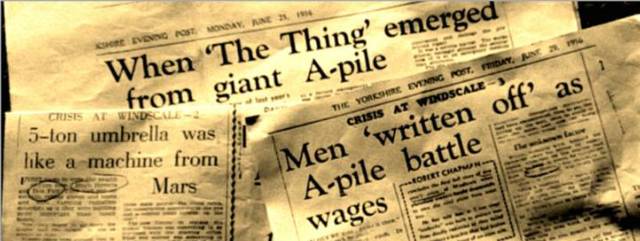Just 18 months before the infamous fire ripped through Windscale’s Pile No 1 on 10th October 1957, a little publicised and largely forgotten major accident in the neighbouring Pile No 2 saw workers fight desperately for over a week to save the reactor from total loss. The crisis, which resulted not from fire or major leak, was caused by the stress failure of a bracket fixed to the inner wall of the reactor’s biological shield where it supported vital scanning gear designed to sniff out any excess radiation from burst fuel cartridges within the Pile.
Described in detail a year later by a series of articles in the Yorkshire Evening Post – much in the style of a boys’ own adventure story which captured the cavalier attitude typical of those days – the 15 x 6 inch bracket had been ripped from the wall and mysteriously appeared in the reactor’s discharge pond at the back of the Pile building along with used fuel cartridges. Dubbed as ‘The Thing’ by workers at the scene, the broken bracket, the cobbled together repair kit and the ‘writing off’ of workers who tackled the crisis were headlined by the Yorkshire newspaper.

Worried that if one bracket had failed ‘the whole thing may be working loose’ and accepting that the Pile could not be re-started until the vital scanning gear could be shown to be safely secured and operating efficiently, the decision was taken to send workers into the reactor to attempt a repair. Refuting the original thinking that, once in operation, it would be fatal for workers to go anywhere inside the 8ft. thick concrete wall that formed the biological shielding of the Pile, a team was nevertheless collected.
With no means of access for maintenance purposes in the Pile’s original design, an entry point was created by draining the water from the 200ft underground duct connecting the reactor to the discharge pond (the use of frogmen to access the pond had been ruled out), the team climbed down a ladder into the duct. Wearing no more than overalls, rubber gloves and boots and allowed no more than 50 minutes per worker in the duct, they entered ‘the deadly inner sanctum of a structure that could destroy the human body in a strange and terrifying way’, hauling with them a repair kit that had been hastily engineered in Heath Robinson fashion.
The repair kit was designed to protect the workers from the Pile’s high radiation levels and consisted, umbrella-like, of a 2-inch thick mild steel structure measuring 18 x 5 ft with doors in the roof. Much of the 5-ton kit had to be assembled inside the Pile and manoeuvred in the confined space between the Pile itself and the biological shield by a relay of work teams who were allowed to work in the drained duct for no more 50 minutes and inside the Pile for 25 minutes.
With mounting pressure to ensure that the repair work had to be continued uninterrupted around the clock if the Pile stood any chance of re-starting – and against the time restraints imposed on workers inside the Pile – the risk of running out of workers for the job was seemingly resolved by the site’s works engineer by having a call-up system – ‘every man in Windscale must take his turn if he’s needed – they’ll be only too glad to’.
Finally completed 10 days after ‘The Thing’ had unexpectedly appeared in the pond, the repair had involved over 200 workers. The Yorkshire Evening Post provides no detail of what would have been the significant radiation doses to which the workers were exposed, of any medical checks undertaken during the crisis or afterwards, or the subsequent health of those involved.
Whilst the true costs in terms of human health to these pioneering workers at a time when Health & Safety was not even a twinkle in officialdom’s eye will never be known – any official records are unlikely ever to see the light of day – it is right and proper that their initiative, ingenuity and bravery in tackling what could have been a fatal disaster for Pile 2 and Britain’s race to produce plutonium for nuclear weapons will be remembered.